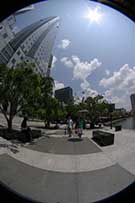

- Adding zenith in ptgui pro full size#
- Adding zenith in ptgui pro manual#
- Adding zenith in ptgui pro Patch#
- Adding zenith in ptgui pro pro#
- Adding zenith in ptgui pro series#
Combine them in Photoshop by blending the two files together. OPTIONAL: You now have the ground portion from “Pano-no_sky.tiff” and the sky portion from “Pano-zenith_edit.tiff”. Most people will not be able to tell this. NOTES: The exported file can be use as it is but due to wrapping and re-wrapping, you will loose some details in the image. Be sure to set optimum size (largest), file type to tiff and file name to “Pano-with_sky.tiff”. Go to Create Panorama tab to export a complete equirectangular image. Go to Image Parameters tab, change the Pitch from 0 to 90 to wrap it back to a normal panorama. You will need to delete the image that’s already in there as you will now have to transform this file into a normal panorama.
Adding zenith in ptgui pro Patch#
After you edit the zenith in Photoshop with content aware fill or patch it with another sky, flatten the file, go back to PTGui that you had opened, under Source Images tab, click the import button (green +) to import fixed “Pano-zenith_edit.tiff”.

Adding zenith in ptgui pro full size#
Go back to Create Panorama tab and export full size image, rename this file to “Pano-zenith_edit.tiff”. Click Advanced button to access hidden tabs.įind Panorama Settings tab, change Projection to “Equirectangular (for spherical panoramas)” FOV of 360ºx180ºįind Image Parameters tab, change pitch to -90 to wrap the image in a way that it would be easier to edit the nadir. In Project Assistant tab, change Lens type to “Equirectangular panorama” with Hor. To patch the Zenith (top), I reload the file exported in step 3, “Pano-no_sky.tiff” into a new instance of PTGui. You will have to come back to this file later. Go to “Create Panorama” tab, set optimum size (largest), change file type to tiff, check output path, change file name to “Pano-no_sky.tiff” and Create Panorama or Save and send to Batch Stitcher. If not, then you will need to patch it later. If all the spherical image data is there, then you will get a complete 360º. After the initial alignment I get the image below. Make sure that all the images are aligned, if any of the images overlap too much it will confuse the program so you will need to delete them. I find PTGui to be one the best stitchers out there in both features and speed. You can use the built-in stitcher in LR or PS to simple stitch.

Adding zenith in ptgui pro pro#
I believe you can also take a zenith (top) shot with your phone and use this as part of your stitch – I have yet to try this method.Īfter the initial adjustment of individual images in LR (lens correction, exposure and white balance), I load them in PTGui PRO for stitching. Next one is 11 and then the next are 7 images.
Adding zenith in ptgui pro series#
I then pitch the camera down 30º, do another yaw/pan series of shots, pitch the camera down another 30º, do another yaw/pan, take a nadir (down) shot, spin 90º, take another nadir shot. As per example below, the first roll comprised of 13 images. With my DJI Inspire 1, I can also pitch the camera up slightly, I would do a yaw/pan shot, this will help me minimize my nadir hole. With a phantom or any other drone, you can choose to yaw the aircraft itself. For 360º spherical, I would do a row of yaw/pan shots. I usually yaw the camera itself with my inspire 1, this help minimise the movement of the drone and also reduce parallax error. So basically, you take a photo, pan the camera to the right, take another shot and repeat until you get around to where you started. This will ensure that you have enough data to process at a later stage. Make sure you have approximately a 30% overlap between each of the photos. For aerial, I usually leave it in full auto as I let the camera expose according to what it is pointing at, otherwise I would end up with some very bright or very dark imaes. This works well when you have a scene that has similar dynamic range, tone and exposure.
Adding zenith in ptgui pro manual#
Normally, you would want to shoot in manual (exposure and white balance), this is done so that all your images will look uniform and correctly exposed. If the horizon does not look right, please tilt your phone up to the ceiling and then back down to normal position, this should fix the viewing issue. You can view the image above interactively here – Tower Hill 360º panorama. You can use your mouse to move around or by simply tilting your phone or tablet.

I been doing panoramas for quite a few years and now with Facebook 360º I can share my work to a wider audience. I use a variety of tools from a DSLR, panoramic head tripod, nodal rail, my drone etc etc, I may need to write another blog on it’s own for all that! It is not an easy process and took me a lot of time and practice to get it to where I am happy. I have been asked a quite few times about how I do my stitched panoramas so I will take you through the steps as simply as I can.


 0 kommentar(er)
0 kommentar(er)
